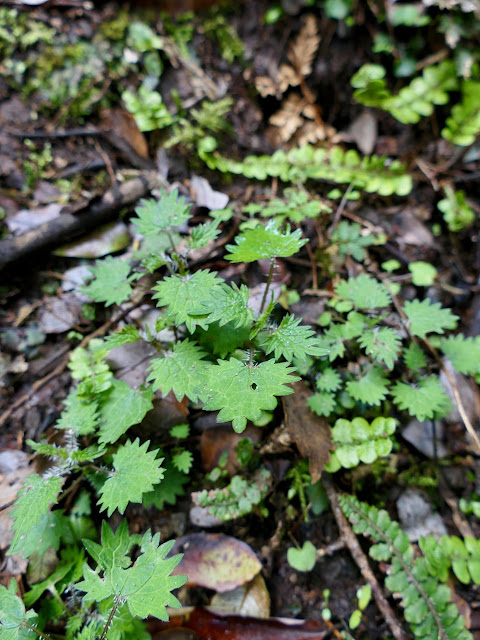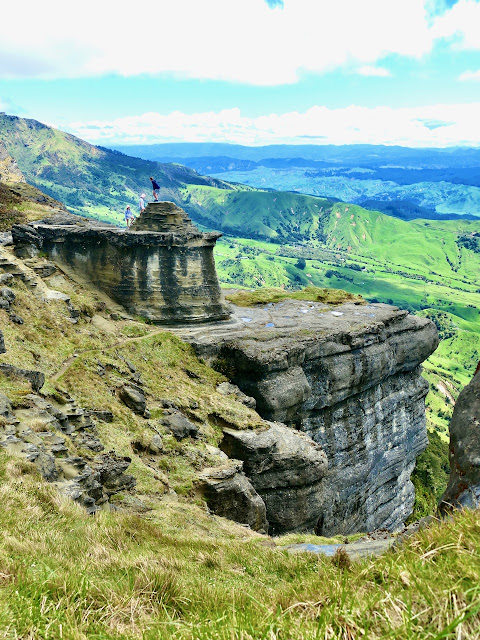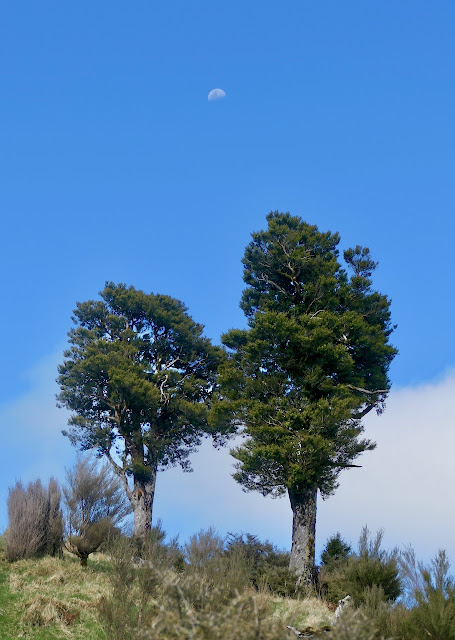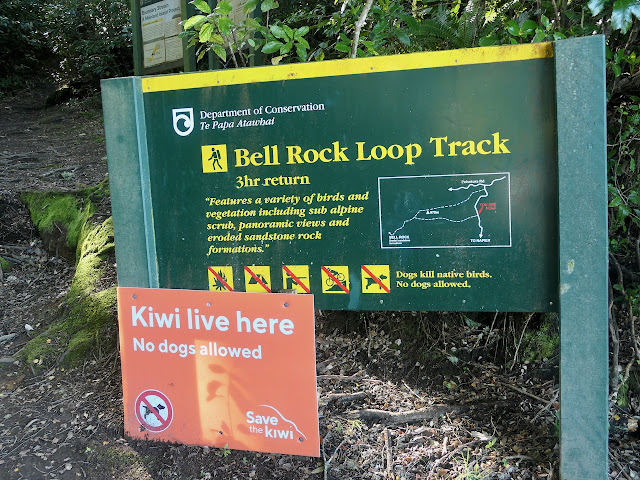It's been 8 months since cyclone Gabrielle rearranged our province. And if you move in certain circles you could probably let yourself forget that there is still such a mess out there. In some respects, it's not until you drive out into the land that you become reacquainted with just what happened and how far we still have to go to put things back in order- to repair lives, homes and restore the land.
We've stayed away from the most devastated areas out of respect and had no reason to travel State Highway 2 until now, but then we decided that October would be an ideal time to walk to Bell Rock especially as Rob had Labour day off, the weather was settled, not too hot, nor too windy and no rain either. From home we calculated that it should take us an hour and a half to get there. Instead it took us two.
But considering that on the 15th February 2023 the state of this road was what you see below it's nothing short of a miracle that it's open at all. Photo NZDF
'Devil's Elbow'
Time stands still.
We'd read a bit about Boundary Stream Scenic Reserve and the walk to Bell Rock loop walk but couldn't quite get the gist of the journey. The DOC info is inevitably a little starchy and seldom to be entirely relied upon, so we decided to trust that we would work it out on the way, but still prepared for our day a little more carefully than usual- plenty of water, something to eat, various layers, spare shoes for me, first aid kit, bandaids, tell Margaret next door where we were going and...maybe we'd get fish and chips when we got home again! Once you get to Tutira there's a big lake and the substance of the land suddenly changes, to richly volcanic confirming this fact with enormous rock formations everywhere! At home in Hastings our soil is always plain and grey and dirt like, but up here when the land opens up you can't help but notice the substrata layers beneath- so much more alive and colourful.
Once you turn off just after the Tutira store you're heading up.
Since I'm not great on practical details I am borrowing Vivienne Haldane's directions on how to get there:
"To reach the start of the track, turn left at the store into Matahorua Road for 4kms, then turn left at the fork into Pohokura Road for another 12kms. Bell Rock is part of the Boundary Stream Mainland Reserve and is just one of several walks here; others include Tumanako Track, Kamahi Loop Track, Bell Bird Bush, and Shine Falls. We stopped at the car park, where signs in a well-built shelter had loads of information about the trails. Rather than walk from here, we decided to park a little further up the road (1.5kms) at a layby. "
You can read her informative article just here.
The 12 kms of unsealed road is ok, just slow. But that's good- you get a chance to chill and observe and hope that no one wants to get passed coming the other way!
We hadn't realised the significance of the 'Boundary Stream Mainland Island'
Until we read this plaque.Free range toilets- the last for a good while.
We have yet to understand exactly where the various walking tracks are in this area but meantime you can find them listed here.
And this is quite useful too- the Land Safety Code helpful for good planning.
Having hopped back in the car and headed up the road to the spot where the sign says 'Bell Rock Loop Track 3 hours' we parked on the side of the road with a good number of others. It's clear as we first step out on to the road that things are different up here: rustic red earth, puddles (a lot greater rain fall); and entirely different flora. The entrance path is steep and sketchy and we soon realised that sturdy footwear is imperative on this walk as there are a lot of tree roots, uneven ground and mud and that it was worth Rob heading back down for walking sticks.
There's a huge preponderance of mature Beech and Rewarewa trees right from the start.
Beech trees are so graceful.
Our pace was slow and measured as we had to keep our eyes on the ground, but at the same time wanted to look up and see everything!
It was fascinating to notice the abundance of Horopito
and native tree fuchsia in the understory.
The fuchsia flowers are tiny- more easily seen as they fall to the forest floor.
"Really! So what are we when we're at home?"
Beech trees are so graceful.
Our pace was slow and measured as we had to keep our eyes on the ground, but at the same time wanted to look up and see everything!
It was fascinating to notice the abundance of Horopito
and native tree fuchsia in the understory.
The fuchsia flowers are tiny- more easily seen as they fall to the forest floor.
It's the trunks of these trees that are most remarkable.
I suddenly tuned in to realise that I had never heard this particular bird song before. It turned out that we were hearing a native Tomtit (Miromiro). You can see and hear this little darling just here.
About now Rob said "Oh look we're at 1000 metres above sea level.""Really! So what are we when we're at home?"
11 metres- I was informed.
There's been a few conversations lately about the knowledge of plants, especially when wild crafting or foraging and how there's so much that most of us don't know. There are not many truly dangerous plants in our landscape, but those that are a potential threat are important to know well.
Like this innocent little seedling on the forest floor called Ongaonga- a native tree nettle that packs a powerful sting, one that would surely ruin the walk if you walked on it in bare feet or thought you'd pick a little for soup. Should you fall in to a mature Ongaonga bush you may even die- painfully.
"Beneath the forest canopy lies a seamless living carpet of mosses, lichens and liverworts. These simple plants not only clothe the forest floor, they grow `wall-to‑ wall’, adorning tree trunks, rocks and even rivers and pools with a spectacular array of colours, shapes and textures." NZ Geographic
"Beneath the forest canopy lies a seamless living carpet of mosses, lichens and liverworts. These simple plants not only clothe the forest floor, they grow `wall-to‑ wall’, adorning tree trunks, rocks and even rivers and pools with a spectacular array of colours, shapes and textures." NZ Geographic
And isn't this a fascinating word- 'totipotent'! 'Mosses and liverworts are said to be totipotent, meaning that literally any part that has broken off can grow into a new plant.'
This lichen appears to be Lobaria pulmonaria and how fascinating are it's other names!
"Lobaria pulmonaria has many common names including tree lungwort, lung lichen, lung moss, lungwort lichen, oak lungs or oak lungwort. The use of "lung" reflects the fact that it looks somewhat like human lung tissue but also connects to the sensitivity of this species to air pollution. Lobaria pulmonaria populations around the world have been declining as a result of human activities and in Estonia the population is estimated to have been reduced by around 90% since the late 19th century."
Info from here.
I adore moss. I felt such joy as we scrambled up this pathway.
This lovely forest is pulsing with life and vitality.
A hanging garden of mosses.
So many interesting ferns along the way too.
All of a sudden there were Totara trees and colonies of Horopito that looked nothing like the forest dwelling versions we'd just passed; neat and shapely it was if they has been newly trimmed and curated.This lovely forest is pulsing with life and vitality.
A hanging garden of mosses.
So many interesting ferns along the way too.
Even some lovely Rimu trees- most unusual to see in Hawke's Bay.
It took us almost an hour to move through the forest (so much to see), but eventually we emerged in to a completely different landscape.
At this point we were heading up the Maungaharuru range and it became quite clear where the path way was- through private farmland.
We were so astonished to see this happy colonization of New Zealand Pepper 'bushes' (Horopito, Pseudowintera Colorata). I wanted to spend time visiting them and walking amongst them but we still had a way to go on our journey and the long grass was pretty wet so my feet were getting wet too. So we kept moving.
The farm track pathway felt like we were walking the Camino de Santiago- The Way!
Suddenly I noticed little white flowers. Bending low, I detected a soft sweet scent, yes our native daphne.
Stand clear- in coming boulder!
The further we walked the more of these unusual family clusters we came across: Totara and Horopito hanging out together.
And then we found some Mountain Holly.
It wasn't until we got home that I discovered what it was. Ollearia Ilicifolia, later there will be attractive white flower clusters.
Of course, when you're following a wide farm track you expect that it will simply guide you in the right direction, but strangely we found the track faded in and out and at one point ended at a fence with no directions. We felt annoyingly lost and had to back track and then follow a narrow rutted track up a steep hill instead.
But then, over the hump and we were there. This bit was unhelpfully steep, without any natural steps heading down, so we were glad that we'd bothered to carry the walking sticks all that way. We walk alot and felt that we would be fit enough to manage The Bell Rock Loop but of course walking over rough terrain that is almost all either going up, or going down is quite hard on the old knees and hips and muscles.
We were astonished at how many families we came across, some of them with very young children. One dad was carrying the 2 year old all the way there in a back pack and even climbed to the top of Bell Rock with her still on his back. We were actually quite pleased when that family started heading home as they were a bit scary all five of them swirling near the edge and talking about flying!
These siblings below were just magic to watch- fearless.
But sesnible.
The light was a bit strange, the valley below and vistas beyond washed in a perpetual haze, but windless was just perfect!
"The rock formations almost look alien, and it's breathtaking to think they were once part of the seafloor and are made up of sediment and seashells.
But sesnible.
The light was a bit strange, the valley below and vistas beyond washed in a perpetual haze, but windless was just perfect!
"The rock formations almost look alien, and it's breathtaking to think they were once part of the seafloor and are made up of sediment and seashells.
Over millions of years, the seafloor compacted, and after some dramatic geological uplift, now sits hundreds of metres above today’s sea level.The area has also been impacted by New Zealand's vast volcanic history including the Taupō eruption of 1800 years ago. The Department of Conservation (DOC) explains the eruption caused "a sheet of hot pumice and volcanic gases that flowed over the land at hundreds of kilometres per hour." Despite being more than 70 kilometres from Taupō’s crater, as the crow flies, the outer edge of flow reached what’s in front of us."
On this flat bit, right near the edge I spotted these familiar bright yellow signs of resilience and thrival. Dandlions!
More native daphne.
When I was about 10 my father must have been working on the Havelock North ski lodge up Mount Ruapehu as we were up there one weekend in summer as a family. I hated the cold and the snow, but I loved this trip 'cos there were amazing flowers and I was entranced. I recall mountain daisies like this one below.
I honestly wouldn't want to take small children up to Bell Rock. There is so much that could go wrong. We were holding our breath when a number of adolescent boys insisted on going right to the edge and shouting in to the void and refusing to move back. All parental instruction was ignored!
A curious, cautious ease and poise felt much safer.
I've borrowed that bit from Brook Sabin's article about Bell Rock here.
At about this point we became aware of a young woman sitting on the rock behind us.
Self assured and fully in the moment we hoped we weren't disturbing her down here.
And then we heard a drone, What, yes a drone. Clang!
I made large biscuits to take on our journey.
These are great- loads of oats & even grated apple. The recipe is just here.
And when I looked down I saw the sea floor!More native daphne.
When I was about 10 my father must have been working on the Havelock North ski lodge up Mount Ruapehu as we were up there one weekend in summer as a family. I hated the cold and the snow, but I loved this trip 'cos there were amazing flowers and I was entranced. I recall mountain daisies like this one below.
I honestly wouldn't want to take small children up to Bell Rock. There is so much that could go wrong. We were holding our breath when a number of adolescent boys insisted on going right to the edge and shouting in to the void and refusing to move back. All parental instruction was ignored!
A curious, cautious ease and poise felt much safer.
Native daphne blooming to the edge!
A trio of ancient, native Tree fuchsias.
Oh how I loved this tree. It feels like a genuine Kiwi Christmas tree. Adorned with Usnea (Angiangi). Every Christmas tree should be made of medicine.
On our decent this Horopito caught my eye- what rich medicine it holds within.
About now Rob was feeling a bit tender with one knee and I was noticing mine. I immediately recalled that Horopito is known as The Bushman's Pain Killer. If needs be we could have nibbled on these wonderfully vibrant leaves to ease our way. We could also have paused and worked our Stomach 36 points- known in Chinese medicine circles as Three Mile Point.
"This is one of the most famous and commonly used acupuncture (acupressure) points. The name of this point reflects its use for accessing deep nourishment and energy when we are worn out and fatigued. “Just 3 more miles. I can make it!"
This soil- so rich and nourishing and red!Moon rising between the Totaras.
And back down we go.
Oh hello who are you? Fernbird maybe? You're surely not a Thrush.
Walking along the path and then hopping up on the post.
When we got home I found him- a Pitpit, Pihoihoi
You can see and hear this wee bird just here.
How cool is that! An 'uncommon' native bird.
It was about this point that I kept seeing the young woman that we'd noticed on the top of the rock, engaged with the majesty of the moment. And then it occurred to me that I may have taken a photo or two of her, but she was quick footed and I never quite caught up with her until...we arrived at the descending juncture where could choose to go back through the forest or, we could head down the ridge and complete the loop. That's when I called out to Maya and we started chatting. And she told us she was worried that we might have thought that it was her drone. Dratted teenage boys!
As we walked down the steep descent we quickly connected and discovered that Maya was a delightful and courageous young Czech/Vietnamese woman travelling and working alone. As we walked together we heard a bird call that was familiar to us- suddenly we realised that we were hearing a male Kiwi call. Then we came upon this sacred site.
Once again I am borrowing Vivienne Haldane's knowledge: "Maungaharuru is the spiritual home of the hapu, Ngāti Kurumōkihi. They are the kaitiaki (guardians) of Boundary Stream and nearby reserves. In 2017, as part of a Treaty settlement to redress grievances from 150 years ago, four DOC reserves in northern Hawke’s Bay were returned to their original owners, hapu (including Ngāti Ngāti Kurumōkihi), represented by the Maungaharuru-Tangitu Trust. Shortly after this, the hapū generously gifted back the four reserves to the people of Aotearoa."
I had had enough by now and my legs were shouting "don't be lost!" But the other two kept looking at their phones and saying we were fine.
Impressive grove of gum trees.
It was about now I was both awed and whiny. "Look at that! Are you sure we're not lost?"
And then quite abruptly we came to a gate, that we had to climb over and then take a right turn and wander back down the road. For the navigationally challenged this was all a bit much 'cos I just knew that I could not walk back up that hill if we'd taken a wrong turn, Kiwi call or not!
It was about this point that I kept seeing the young woman that we'd noticed on the top of the rock, engaged with the majesty of the moment. And then it occurred to me that I may have taken a photo or two of her, but she was quick footed and I never quite caught up with her until...we arrived at the descending juncture where could choose to go back through the forest or, we could head down the ridge and complete the loop. That's when I called out to Maya and we started chatting. And she told us she was worried that we might have thought that it was her drone. Dratted teenage boys!
As we walked down the steep descent we quickly connected and discovered that Maya was a delightful and courageous young Czech/Vietnamese woman travelling and working alone. As we walked together we heard a bird call that was familiar to us- suddenly we realised that we were hearing a male Kiwi call. Then we came upon this sacred site.
Once again I am borrowing Vivienne Haldane's knowledge: "Maungaharuru is the spiritual home of the hapu, Ngāti Kurumōkihi. They are the kaitiaki (guardians) of Boundary Stream and nearby reserves. In 2017, as part of a Treaty settlement to redress grievances from 150 years ago, four DOC reserves in northern Hawke’s Bay were returned to their original owners, hapu (including Ngāti Ngāti Kurumōkihi), represented by the Maungaharuru-Tangitu Trust. Shortly after this, the hapū generously gifted back the four reserves to the people of Aotearoa."
I had had enough by now and my legs were shouting "don't be lost!" But the other two kept looking at their phones and saying we were fine.
Impressive grove of gum trees.
It was about now I was both awed and whiny. "Look at that! Are you sure we're not lost?"
And then quite abruptly we came to a gate, that we had to climb over and then take a right turn and wander back down the road. For the navigationally challenged this was all a bit much 'cos I just knew that I could not walk back up that hill if we'd taken a wrong turn, Kiwi call or not!
And then...I stopped mid- stride arrested by a flower I had never seen in my life before.
Apparently this is a Mountain Foxglove
Ourisia macrophylla
So exciting!!!
And then there were Bluebells- long finished at home.
Next thing- Maya spotted her van. She's been living out of it for a year as she works and travels.
We said our goodbyes but as the van came offered sustenance in the way of spare huge biscuits through the van window, a shower and a bed for night in Lucy- our vintage caravan, back in Hastings. Maya said she'd be in touch as she headed off to reach Te Mata Peak before the sunset.
Our return journey was so much quicker- down hill all the way!
Apparently this is a Mountain Foxglove
Ourisia macrophylla
So exciting!!!
And then there were Bluebells- long finished at home.
Next thing- Maya spotted her van. She's been living out of it for a year as she works and travels.
We said our goodbyes but as the van came offered sustenance in the way of spare huge biscuits through the van window, a shower and a bed for night in Lucy- our vintage caravan, back in Hastings. Maya said she'd be in touch as she headed off to reach Te Mata Peak before the sunset.
Our return journey was so much quicker- down hill all the way!
The walk itself though is hard. Let's be honest. I've heard people say that 'everyone' should come here, but that's just not realistic. I would not call it an easy or even moderate walk. An 8 km 3 hour walk sounds fine, but then there's the context of this particular terrain and there is very little that is flat in this trail. We are so glad that we have managed, but we wouldn't go again tomorrow.
We were amazed, on our way home, to see how little the land has healed since the cyclone in mid February.
 I started making pasta with roasted asparagus and smoked salmon (from the Farmer's Market) when we arrived home. Soon enough Maya checked in to tell us she was on her way.
I started making pasta with roasted asparagus and smoked salmon (from the Farmer's Market) when we arrived home. Soon enough Maya checked in to tell us she was on her way.

And she stayed- in Lucy our little vintage caravan. And we had the most heartfelt and wonderful time together.
 Our shared motto" "Live for joy".
Our shared motto" "Live for joy".

We surely will.





.jpeg)





.jpeg)
.jpeg)
.jpeg)


.jpeg)
.jpeg)
.jpeg)

.jpeg)
.jpeg)
.jpeg)



.jpeg)

.jpeg)
.jpeg)




.jpeg)

.jpeg)


.jpeg)
.jpeg)
.jpeg)


.jpeg)
.jpeg)



.jpeg)




.jpeg)
.jpeg)


.jpeg)
.jpeg)


.jpeg)
.jpeg)

.jpeg)
.jpeg)
.jpeg)
.jpeg)
.jpeg)
.jpeg)






.jpeg)
.jpeg)






.jpeg)

.jpeg)

.jpeg)

.jpg)



.jpeg)
.jpeg)